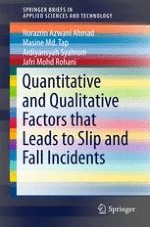This book investigates the factors that lead to slip and fall incidents and establishes a relationship between the coefficient of friction (COF), floor slipperiness and floor roughness. It also examines human perception of slipperiness through measured coefficient of friction (COF). On the basis of questionnaire surveys among manufacturing workers, it identifies potential risk factors and assesses human perceptions of slipperiness. It also uses a tribology approach to relate the interaction between contaminants, floor and footwear materials.
